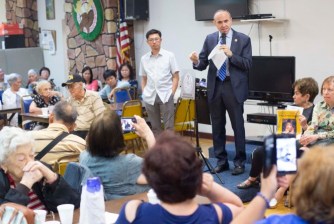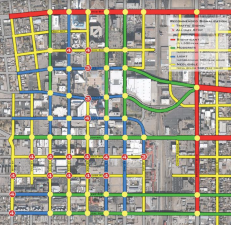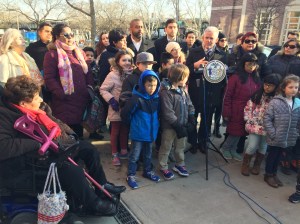Is Another Stop Light the Best Fix for Livable Streets?
Last week, the New York Times profiled David Bookstaver, who after six years succeeded in getting DOT to install a stop light at East 85th Street and East End Avenue. Whether Mr. Bookstaver’s victory will result in a safer crossing remains to be seen, and stop lights, though popular with the public, are not the only tool the city can use to slow traffic.

Bookstaver’s campaign began in 2006. Not wanting to “wait like we normally do in New York for a kid to get run over or an old lady to get crushed,” he began his quest for a stop sign at the only East End Avenue intersection without any stop signs or signals.
After what Bookstaver describes as a frustrating meeting with the Community Board 8 transportation committee in 2008, he learned that a stop sign would not be considered for the intersection. He shifted his focus to getting a stop light, but DOT determined that the intersection did not meet the necessary criteria. DOT offered to install yellow signage altering drivers to the crosswalk, but Bookstaver balked, according to the Times.
Bookstaver then worked with Council Member Jessica Lappin’s office to request another study. A traffic signal was finally installed in late August.
Streetsblog asked Bookstaver if he or DOT considered other traffic-calming measures, such as pedestrian refuge islands or curb extensions. “That never came up,” he said. “What came up was me asking for a stop sign, because I thought it was realistic. And I got something better.”
East End Avenue isn’t the only street to have traffic signals installed in the name of pedestrian safety. When Kent Avenue in Williamsburg was redesigned in 2009, DOT didn’t stripe crosswalks at intersections without traffic signals, which cut off the redeveloping waterfront from the rest of the neighborhood. The street received additional stop lights this year after residents complained that it was difficult to cross. Last February, Tribeca residents won a signal light at the intersection of Greenwich and Duane Streets after a child was struck by a cab driver. DOT had previously determined that the intersection was not busy enough for a light.
Noah Budnick of Transportation Alternatives, which was not involved in the campaign for a traffic signal on East End Avenue, welcomed Bookstaver’s neighborhood advocacy. “It goes to show that the demand for safe streets has penetrated deep into blocks and neighborhoods all around the city,” he said.
At the same time, there are a number of options in addition to traffic signals that are available to calm traffic. “It allows a much more tailored approach to unique neighborhoods around the city,” Budnick said. “New Yorkers would really benefit from learning about all of the different options that we have now.”
Traffic signals are not a panacea. Although there are many cases where stop lights are necessary, they are often requested when other interventions would be better for pedestrians, and for drivers. Red-light running killed 762 and injured 165,000 nationwide in 2008. In addition to costing tens of thousands of dollars to install, traffic engineers warn that they can actually lead to an increase in crashes when placed at inappropriate locations. The intersection of East 85th Street and East End Avenue had failed to meet requirements for a traffic light at least twice before DOT approved the project.
DOT already has a number of other tools it uses regularly, including speed humps, slow zones, road diets, lane narrowing and curb extensions. But there are also tried-and-true interventions employed in other U.S. cities that the agency isn’t using. Many would fit in well on the city’s wide variety of streets, and though many make appearances in DOT’s Street Design Manual, you’d be hard-pressed to find them in New York neighborhoods.
New York has few raised crosswalks, for example, which have a proven track record of getting more drivers to stop for pedestrians. Many cities have also installed chicanes, which encourage drivers to slalom slowly, rather than gun it to the next intersection. There are many quieter New York streets that could gain from this effective intervention.
With separated bike lanes, slow zones, public plazas and other improvements, there can be no doubt that DOT has raised the bar over the last five years. In an effort to bridge the gap between experts and the public, the Planning Fellowship Program pairs city planning students with community boards, which for better or worse are allowed by the city to hold sway over neighborhood street design. A bill introduced by Council Member Leroy Comrie would provide planning assistance to all community boards through a pool of professionals and students in each borough.
In the future, maybe the public won’t view the ubiquitous stop light as the only way to keep themselves and their families safe from reckless motorists. “I don’t know what a curb extension is,” said Bookstaver. “I just wanted something to stop cars.”


